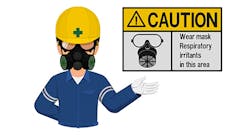In a decision published Sept. 11, the U.S. Court of Appeals for the Ninth Circuit ruled that the Occupational Safety and Health Administration (OSHA) Respiratory Protection Standard requires that employers adequately evaluate all appropriate respiratory hazards before determining if a respirator is required as well as to select an appropriate respirator.
The case began in 2009 when workers’ complaints drew OSHA inspectors to the marine vessel repair facilities operated in Seward, Alaska, by Seward Ship's Drydock Inc., which at that time performed both drydock and dockside repairs and maintenance on ships and barges.
The company was in the process of performing welding within a ship’s voids (empty compartments designed to contribute to the vessel’s buoyancy). Respirators had been offered to the welders on a voluntary basis, but only one had chosen to do so.
The site superintendent, who also was the designated “shipyard competent person” and held a marine chemist certificate, conducted atmospheric testing where work would take place. Before welding began, he tested the voids using a “grab sample,” which provides an immediate measurement from a gas meter.
The tests determined whether gas levels in the voids were “safe for entry” at the time the test was performed. However, he did not test for the metals found in welding fumes. The welding fumes present contained iron oxide, manganese, fluorides and barium compounds. Overexposure to them can cause respiratory difficulties, and overexposure to iron oxide can cause siderosis, commonly known as “iron lung.”
Two of the welders later testified that the air quality in the voids was very poor and described it as smoky. They filed complaints with OSHA and compliance officers later found there was improper ventilation and visible fumes. They took grab samples to test for carbon monoxide and attached personal exposure monitoring devices to two welders.
The inspectors then issued citations for 13 violations for failing to adequately test the atmosphere in the voids, exposing employees to inhalation hazards. They determined that the testing conducted by Seward did not address permissible exposure limits (PELs) for several chemicals.
Ten Years of Appeals
Seward challenged the finding and a federal administrative law judge (ALJ) agreed with the company, holding that the site superintendent’s grab sample which tested only for gases was adequate to protect the safety of the welders.
OSHA appealed to the Occupational Safety and Health Review Commission (OSHRC), which after conducting briefings from the parties involved, chose to uphold the ALJ’s decision against the agency. OSHA then appealed that decision to the federal appeals court, which reversed OSHRC and found that OSHA’s interpretation of the law and its own regulations was correct.
The court concluded that OSHA’s Respiratory Protection Standard requires employers to evaluate potentially harmful atmospheres to determine whether respirators are required and in selecting the appropriate respirator, rather than performing this evaluation after a determination has been made that respirators are necessary.
In reaching its decision, the court looked to the overall purpose of the Respiratory Protection Standard and concluded the standard was not ambiguous. It said the ALJ and OSHRC had given excessive weight to the fact that the provision requiring the employer to identify and evaluate the respiratory hazards in the workplace was in the section of the standard titled “Selection of Respirators.”
In other words, the court reversed the commission’s position that evaluation of respiratory hazards was required only after a determination had been made that respirators were necessary and upheld OSHA’s argument that an evaluation of respiratory hazards was required to determine whether a respirator was necessary and then to select the appropriate respirator.
In light of this opinion, employers should re-evaluate their procedures for determining when it is reasonable to suspect that an employee may be exposed to harmful concentrations of airborne contaminants, says attorney Lawrence P. Halprin of the law firm of Keller and Heckman. This also should be the case when evaluating potential exposures based on anticipated workplace conditions and reasonably foreseeable emergencies (such as ventilation failure).
“This opinion suggests the possibility that OSHA may attempt to make greater use of the Respiratory Protection Standard rather than the General Duty Clause to address allegedly harmful airborne contamination that is not addressed by a PEL or is below a current PEL,” Halprin warns.
